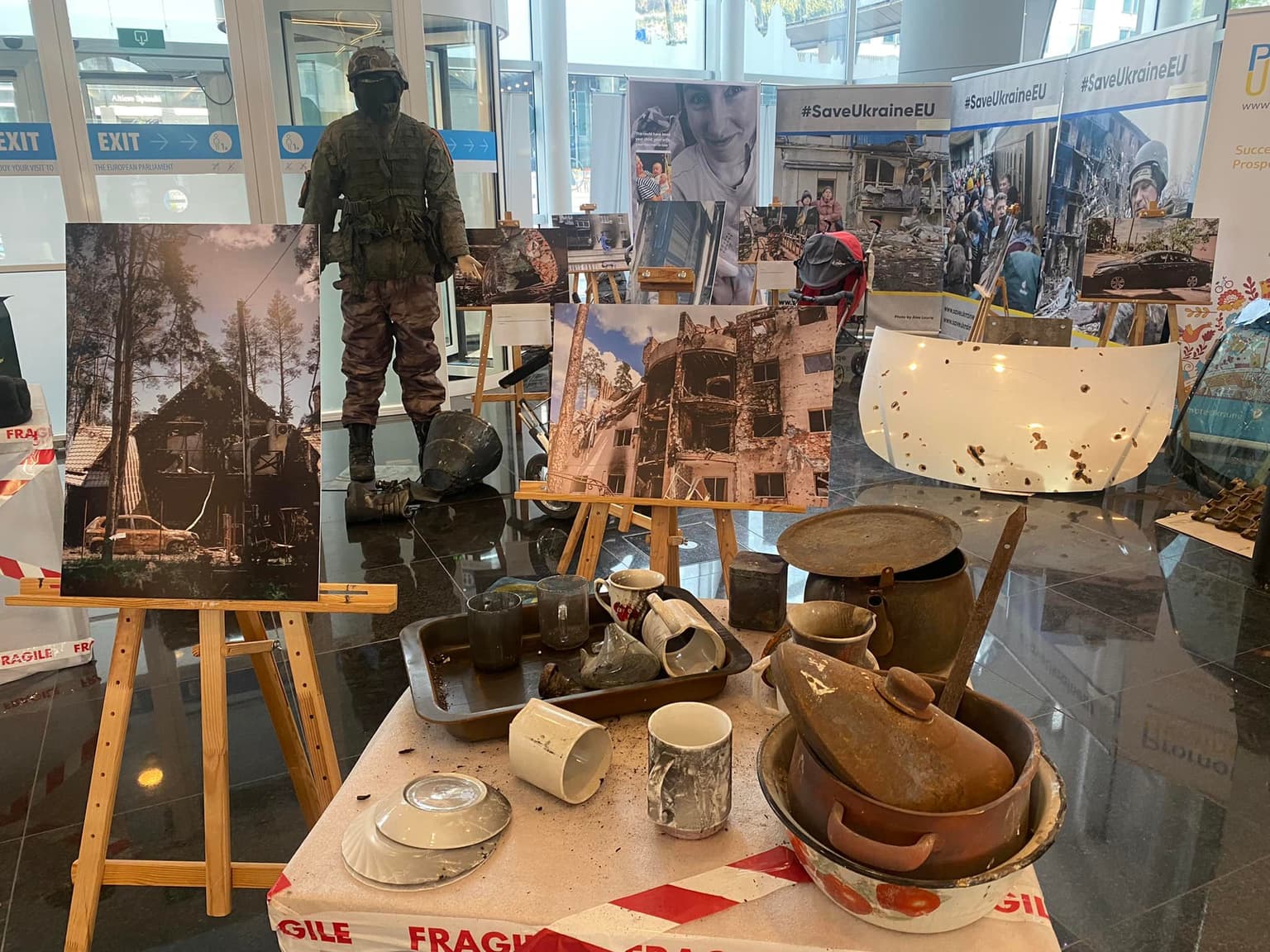‘Irpin. Invincible’: Exhibition in Brussels highlights cost of Russia’s war

At the heart of the European Parliament in Brussels, a grand August Förster piano lies in pieces on the floor, blackened and burned. Now far from home, the instrument once stood proudly inside Irpin’s Central House of Culture, which was destroyed by shelling during the Russian army’s failed assault on the city.
Just several months prior to Russia’s invasion of Ukraine, the piano had been used as part of numerous performances by Ukrainian musicians. Now, along with much of the city’s cultural heritage, it lies in ruins.
Ukrainian organization Institute for Global Transformation painstakingly shipped the relic, as well as other artifacts from the battle for the city just west of Kyiv, to Europe as part of the “Irpin. Invincible” exhibition, inaugurated by Irpin Mayor Oleksandr Markushyn on June 3.
The exhibition catalogs the extent of the damage inflicted on Irpin, which has now been designated a “Hero City” for its resistance against Russian invaders.
Damaged baby strollers, complete kitchens and bedrooms, and moving photos detail the extent of the destruction inflicted by Russian forces, highlighting the human cost of battle for the city.

Irpin Investment Council Chairman Volodymyr Karpliuk said that Irpin “had suffered” to protect Ukraine’s capital, Kyiv.
“We didn't have a story like in other towns where there were huge losses in population,” however, Irpin took on some of the heaviest fighting in Kyiv Oblast, Karpliuk said. “Irpin accepted this fighting and did not allow the enemy to come further.”
The Irpin City Council launched the exhibition in an attempt to raise money for the reconstruction of the city. Since the start of Russia’s all-out war, over 70% of Irpin’s buildings were damaged as a result of the fighting, according to Markushyn.
“The shells damaged more than 8,000 sites to one degree or another. More than 2,000 sites — the private sector, apartment buildings, and social infrastructure — have been destroyed forever. Some 4,000 apartments and almost 2,000 private homes will never be rebuilt. We have entire neighborhoods that have been completely burned down by large-scale artillery shelling,” Karpliuk said.

According to the council chairman, the exhibition is set to tour other European cities before moving to the U.S. The exhibition will move to Paris on June 8, under the name “Ruined but undefeated Irpin.”
Members of the European press and parliament were welcomed in Brussels by the Irpin mayor, who recounted the defense of the city to the event’s attendees.
On the first day of the assault on Irpin on Feb. 27, the city’s bridge was destroyed by the Ukrainian military in order to prevent its use by Russian invaders. In order to evacuate local citizens, the city’s authorities ferried residents by foot using improvised crossings.
Photos displayed at the exhibition showed Ukrainian civilians hiding underneath the destroyed crossing as Russian shelling threatened evacuees.
“The only route of evacuation from Iprin was across the bridge…We evacuated 40,000 of our inhabitants. Can you imagine, 40,000?,” Markushyn told members of the press. “Everything happened under attacks, shooting, bombing.”
As Russian forces pushed through the city of Bucha, Kyiv Oblast, committing arbitrary killings of Ukrainian residents, Irpin became a focal point of intense fighting, with Russian troops intending to encircle Kyiv. Around 50 Ukrainian soldiers and up to 300 civilians died during the battle, according to Markushyn.
“The most emotional and hardest moment for me was the killing of families. Sixty-meters ahead of me, there was a woman, two young children, and a volunteer. A bomb fell on them and killed all four. It was the worst thing I saw in my life,” Irpin’s mayor recalled.

At the center of the EU building, a reconstructed child’s bedroom from the city, scorched and destroyed by enemy shelling, served as a reminder of the civilian cost of the war.
Photos and paintings also depicted the loss of the Irpin’s sporting, cultural, and historical heritage.
Though Russian forces have withdrawn from the north of Ukraine where Irpin is and focused on offensives in the east and south of the country, Irpin remains an important obstacle to further assaults on Kyiv in case Russia renews them.
According to Hanna Maliar, Ukraine’s Deputy Minister of Defense, capturing Kyiv remains Russia’s main goal.
Ukrainian commander and politician Roman Kostenko has warned that the chance of renewed attacks against Kyiv are still “high,” potentially spearheaded by troops from Belarus.
Ukrainian troops have been deployed along the length of the shared 1,080 kilometer border with Belarus in anticipation of possible escalation.
In a comment to the Kyiv Independent, Irpin’s mayor said that the city is prepared for this eventuality.
“There really are worries that there could be a second phase of the invasion of Kyiv. However, today we already have extra defenses that will ensure that (the Russians) will not even reach Irpin,” Markushyn said.
“Should there be an invasion from Belarus, our territorial defense will depart north to be able to fight back. There can't be a peaceful Irpin without a peaceful Bucha, Vorzel, Hostomel and other towns, so we are fighting for all of them,” Markushyn said.










